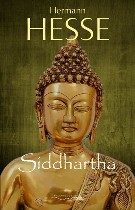 Hermann Hesse •
Hermann Hesse •
Siddhartha •
There is something deeply satisfying about reading a book where everything comes right in the end. As human beings meshed in untidy lives, we long for happily-ever-after conclusions.
Siddhartha delivers this in a big, if unorthodox, way. With its spare language and Eastern theme, the book represents a radical departure from the filigreed romanticism of Hesse’s other novels. A crystalline voice describes one man’s spiritual journey of centuries past, summed up in the simple chant “I can think. I can wait. I can fast.”
In the years since I first read it, I’d forgotten how much I liked this book. Back in 1968 my friend Amy lent me her New Directions paperback with its stark black-and-white cover, and I fell under its spell at once. I must have read every book Hesse ever wrote, burrowing into Magister Ludi or Steppenwolf when I was supposed to be studying.
And I wasn’t the only one. Hesse’s work held widespread appeal for the counterculture movement of the 1960s and 1970s, as a whole generation looked beyond materialism to more enduring values. The German writer seemed to know an important secret that I desperately wanted to be let in on.
“Govinda bowed low; tears, of which he knew nothing, ran down over his old face; the feeling of most intimate love, of most humble reverence burned like a fire in his heart. Deeply he bowed, down to the earth, before the one who sat motionless, whose smile reminded him of everything he had ever loved in all his life, everything he had ever in all his life valued and held sacred.”
Maybe it’s time for a Hesse revival.





Your email address will not be published.